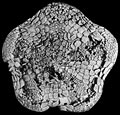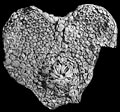The Echinoid Directory
Pronechinus Kier, 1965, p. 461
| Diagnostic Features |
|
|---|---|
| Distribution | Upper Permian, Turkey. |
| Name gender | masculine |
| Type | Pronechinus anatoliensis Kier, 1965, p. 462, by original designation. |
| Species Included |
|
| Classification and/or Status |
|
| Remarks |
|


